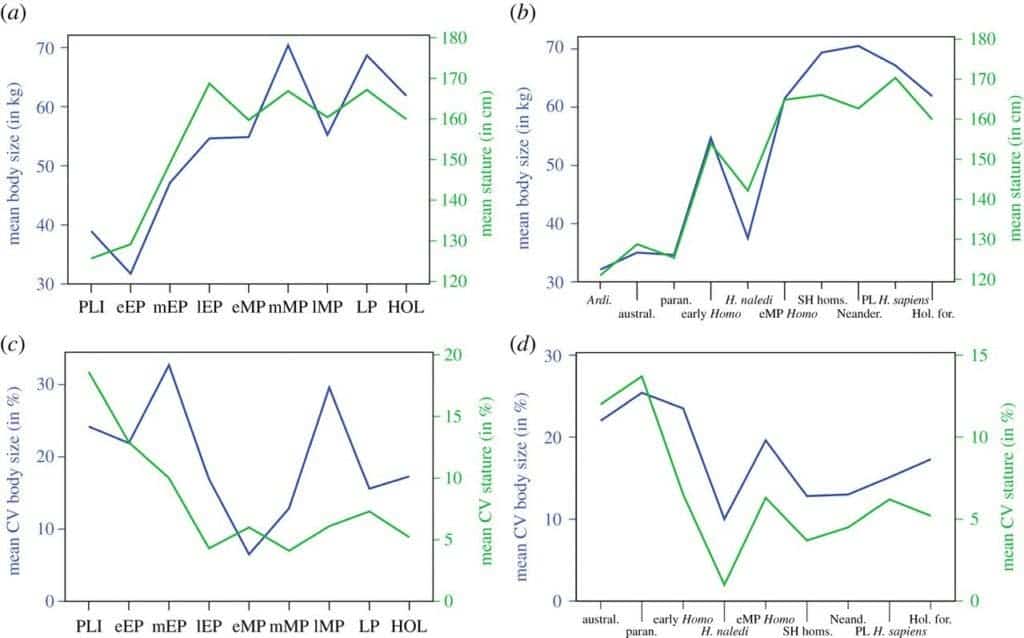Hominins have seen “pulses” of growth during their evolutionary history, followed by periods of “stagnation,” a new paper reports. This was the widest-scale study on the evolution of human stature and weight to date. Data was drawn from hominid fossils spanning the entire known evolutionary path of the genus. It reveals that over the last four million years, hominid stature and body mass have increased independently and at different speeds. Some extinct lineages even went through phases of shrinking.

The paper drew on 311 specimens dating from roughly 4.4 million years ago (the time of the earliest known upright hominid species) through to the modern humans that followed the last ice age. It’s the largest study of hominid body size evolution to date, and the authors conclude that although this was a “long and winding road with many branches and dead ends,” the overarching pattern they’ve observed is one of bursts of growth followed by millennia of ‘stagnation’.
Taller, bigger, better
Earlier hominin evolution saw a wide range of body sizes, mostly owed to the number of different species and their particular evolutionary roots. Some were broad, ‘gorilla’-like, such as Paranthropus, or slimmer and agiler, as was Australopithecus afarensis. On average, hominins from four million years ago weighed a roughly 25kg and stood at 125-130cm tall. Observing how physicality evolved over time, however, the team reports at least three major “pulses” of significant changes.
The first one occurred as our own genus, Homo, made an appearance around 2.2-1.9 million years ago. This period saw an increase in both height (of about 20 cm) and weight (of between 15-20 kg).
Stature and height further separated about 1.4 to 1.6 million years ago, following the emergence of Homo erectus. Fossil evidence shows that hominid species living around this time grew taller by roughly 10 centimeters (3.93 inches) but wouldn’t significantly gain in body mass for another million years. This is the point where a familiar stature was reached. Body mass still remained lower on average than today.
It would take roughly one million years (around 0.5 to 0.4 million years ago) before heavier hominids made a consistent appearance in the fossil record. On average, hominid species saw a body mass increase of 10-15 kgs (22-33 pounds) about 500,000 years ago. This increase in body mass likely points to an adaptation to environments north of the Mediterranean.

Image credits Manuel Will, Adrián Pablos, Jay T. Stock, 2017, RSOS.
“From then onwards, average body height and weight stays more or less the same in the hominin lineage, leading ultimately to ourselves,” says lead author Dr Manuel Will from Cambridge’s Department of Archaeology, and a Research Fellow at Gonville and Caius College.
There are a couple of exceptions, as is the case for Homo naledi and Homo floresiensis, which have in fact decreased in size over time, the team reports. However, this was likely due to their evolutionary roots in smaller-bodied ancestors, or the effect of evolutionary pressures acting on isolated and small populations. Floresiensis, for example, was discovered on an Indonesian island.
“Our study shows that, other than these two species, hominins that appear after 1.4m years ago are all larger than 140cm and 40kg. This doesn’t change until human bodies diversify again in just the last few thousand years.”
“These findings suggest extremely strong selective pressures against small body sizes which shifted the evolutionary spectrum towards the larger bodies we have today.”
Sizing up to the requirements

The findings could help us better understand what early hominids were up to. Initially, hominid height and weight largely evolved “in concert,” the team adds. The latter decoupling between height and bulk were likely caused by early humans’ migration out of the forest and as an adaptation to hunting in the savannah.
“An increase solely in stature would have created a leaner physique, with long legs and narrow hips and shoulders. This may have been an adaptation to new environments and endurance hunting, as early Homo species left the forests and moved on to more arid African savannahs.” Dr Will adds.
“The higher surface-to-volume ratio of a tall, slender body would be an advantage when stalking animals for hours in the dry heat, as a larger skin area increases the capacity for the evaporation of sweat.”
Later, as these populations moved further north and ran into colder climates, the increase in bulk would make them better at fighting the cold.
“The later addition of body mass coincides with ever-increasing migrations into higher latitudes, where a bulkier body would be better suited for thermoregulation in colder Eurasian climates.”
The results also suggest cladogenesis (lineage-splitting) may have played a part in increasing the average human’s height and mass. It’s possible that inter-species competition later drove the smaller-bodied lineage extinct. Sexual dimorphism — the physical distinction between genders, with mammalian females typically smaller than males — was also more prevalent in early hominid history, the authors added, and seems have become less emphasized.
However, Will says the theory should be taken with a grain of salt. It suits the available data very well, but there are vast gaps in the fossil record that the team has had to work around, ones that may have obscured the truth. He notes that at times, the team had to work on body size estimates starting from very fragmented remains, in some cases from as little as a single toe bone.
Overall, we know certain groups of humans have continued getting taller over the last century, most likely due to improvements in nutrition and healthcare. As these keep increasing, it’s likely that the average human stature is going to keep increasing.
“However, there is certainly a ceiling set by our genes, which define our maximum potential for growth,” said co-author Dr Jay Stock, also from Cambridge’s Department of Archaeology.
The paper “Long-term patterns of body mass and stature evolution within the hominin lineage” has been published in the journal Royal Society Open Science.


